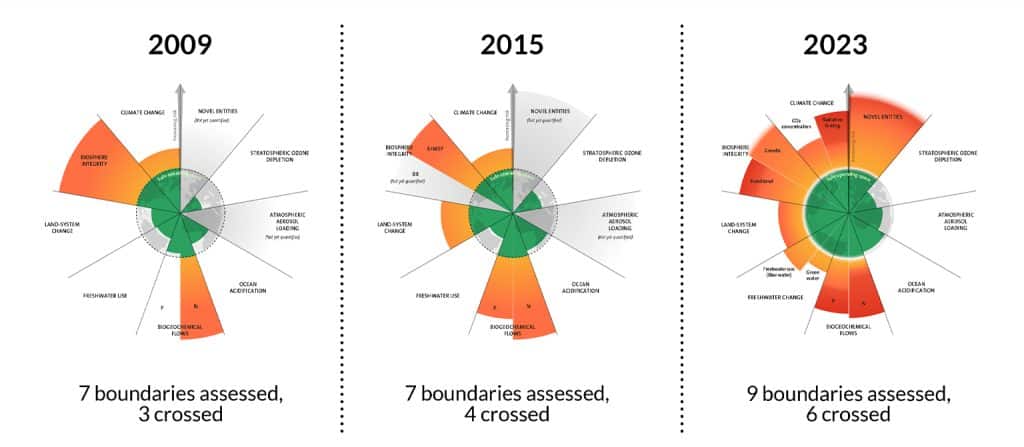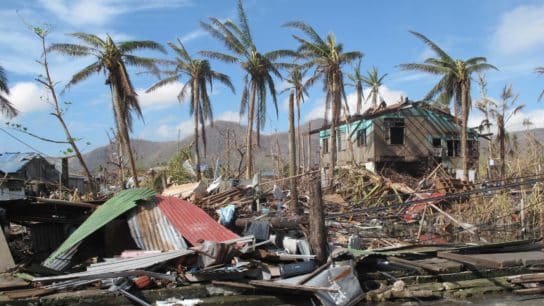Researchers found that every fraction of a degree matters when it comes to whether or not climate tipping points will be breached, stressing that emissions reduction policies today will determine climate patterns hundreds of years into the future.
—
Reaching and sustaining net-zero greenhouse gas emissions by 2100 is “paramount” to minimize the risk of irreversibly affecting climate patterns, new research has found.
In a study on climate tipping points published in August in Nature Communications, researchers said that every emissions reduction policy adopted this century will determine how climate patterns will change in the centuries to come.
Tipping points refer to multiple stable states of different planet’s life-support systems that all societies depend on and that, if pushed too far, could result in unstoppable, permanent, and irreversible changes in their state. For instance, continuous external pressure on a system like the Amazon rainforest, the world’s largest and richest biological reservoir and one of the most important natural carbon storage systems, can turn the forest into a savannah and a source of carbon dioxide.

Researchers focused on four, interrelated tipping points: the collapse of the Greenland ice sheet and the West Antarctic ice sheet, which would lead to substantial sea level rise, the transitioning of the Amazon rainforest into a dry savanna, and the collapse of the circulation of the Atlantic Ocean, a key component in global climate regulation also known as the Atlantic meridional overturning circulation (AMOC). A weakening AMOC would cause a decrease in the ocean’s effectiveness in absorbing atmospheric carbon dioxide, leading to a higher amount of greenhouse gasses in the atmosphere. It would also lead to more hurricanes in the southern ocean and the rapid cooling of Europe, with devastating consequences for agriculture and life in the region.
More on the topic: What the Slowdown of Atlantic Ocean Circulation Means for the Future of the Climate
Previous studies showed that all four tipping points are already within reach; a February 2024 study also suggested that the AMOC is “on route” to a tipping point. Now, researchers say that under current scenarios, these tipping points could occur in the next 300 years.
The authors found that every additional 0.1C degree of warming past the critical 1.5C threshold would increase the risk of triggering crucial tipping events between now and 2300 and “strongly” accelerate peak warming above 2C. According to the study, the breaching the 1.5C global warming threshold is now a “distinct possibility.” And even if temperatures are brought back to below the critical benchmark set in 2015 as part of the Paris Agreement, current emissions reduction policies would still commit to a 45% tipping risk by 2300.
“Our results show that only achieving and maintaining net zero greenhouse gas emissions, associated with a long-term decline in global temperatures, effectively limits tipping risks over the coming centuries and beyond in line with earlier studies,” the authors wrote.
So far, the world has warmed by 1.3C compared to pre-industrial times. The burning of coal, natural gas, and oil for electricity and heat is the single-largest source of global greenhouse gas (GHG) emissions. These are the primary drivers of global warming as they trap heat in the atmosphere and raising Earth’s surface temperature. The International Energy Agency (IEA) has urged countries to halt new gas and oil field projects, arguing that this is the only way to keep the 1.5C-compatible net-zero emissions scenario alive. And yet, global fossil fuel consumption has yet to peak. In 2023, the atmospheric concentration of all three of the most potent GHGs – carbon dioxide (CO2), methane, and nitrous oxide – reached a record high.
“The findings emphasize that immediate and substantial emissions cuts are essential in the next decade to avoid these tipping points and prevent long-term damage to the climate,” study author Tessa Möller told Axios.
The study was co-authored by earth scientist Johan Rockström, who pioneered research on the planetary boundaries framework. The nine planetary boundaries presented in the framework are argued to be fundamental in maintaining a “safe operating space for humanity.” First published in 2009, the framework has served, and continues to serve, as a valuable guide for policymakers, urging them to consider the long-term consequences of human actions and adopt strategies that prioritize the sustainable use of Earth’s resources.

“Boundaries are set to avoid tipping points, to have a high chance to keep the planet in state as close as possible to the Holocene, that allows it to maintain its resilience, stability, and life support capabilities. Go beyond and we enter a danger zone… the uncertainty range of science,” Rockström told Earth.Org in April. In 2023, he and other scientists found that six of the nine planetary boundaries are already transgressed, placing the Earth “well outside of the safe operating space for humanity.”
Read the full interview with Johan Rockström here.
This story is funded by readers like you
Our non-profit newsroom provides climate coverage free of charge and advertising. Your one-off or monthly donations play a crucial role in supporting our operations, expanding our reach, and maintaining our editorial independence.
About EO | Mission Statement | Impact & Reach | Write for us














